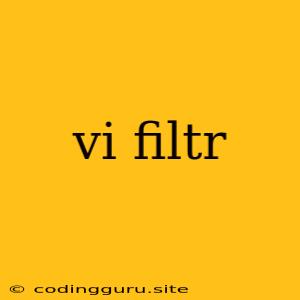Vi: The Powerful Command-Line Text Editor
Vi (pronounced "vee-eye") is a powerful and versatile text editor that is commonly used on Unix-like systems. It's a modal editor, which means it operates in different modes depending on your intended action. This can seem daunting at first, but mastering vi's modes unlocks its potential for efficient and precise text editing.
Why Use Vi?
- Ubiquitous: Vi is available on practically every Unix-like system, making it a universal tool.
- Efficient: Vi is designed for speed and efficiency, with shortcuts and commands that allow you to navigate and edit text quickly.
- Powerful: Vi provides a rich set of commands for advanced text manipulation, search, and replacement.
- Remote Access: Vi is perfect for editing files over SSH or other remote connections.
Modes in Vi
Vi operates in three main modes:
- Command Mode: This is the default mode when you launch vi. In this mode, you can navigate the text, issue commands, and enter other modes.
- Insert Mode: Used to enter text directly into the file. You enter Insert Mode by pressing i, a, o, or other insert-related keys.
- Visual Mode: This mode allows you to select and manipulate blocks of text. You can enter Visual Mode by pressing v (for character-wise selection) or V (for line-wise selection).
Basic Commands in Vi
Here are some essential commands you'll need to know:
-
Moving the Cursor:
- h: Move left
- j: Move down
- k: Move up
- l: Move right
- w: Move to the beginning of the next word
- b: Move to the beginning of the previous word
- 0: Move to the beginning of the line
- $: Move to the end of the line
- G: Move to the end of the file
- gg: Move to the beginning of the file
- nG: Move to line number n
-
Deleting Text:
- x: Delete the character under the cursor
- X: Delete the character before the cursor
- dw: Delete the word under the cursor
- dd: Delete the current line
- D: Delete from the cursor to the end of the line
- d$: Delete from the cursor to the end of the line
- dG: Delete from the cursor to the end of the file
- dgg: Delete from the cursor to the beginning of the file
-
Inserting Text:
- i: Enter Insert Mode before the cursor
- a: Enter Insert Mode after the cursor
- o: Open a new line below the current line and enter Insert Mode
- O: Open a new line above the current line and enter Insert Mode
-
Searching and Replacing:
- /pattern: Search for a pattern forward
- ?pattern: Search for a pattern backward
- n: Repeat the last search
- :s/old/new/g: Replace all occurrences of "old" with "new" in the entire file
Using Vi Effectively
- Start Simple: Begin with the basic commands and gradually learn more advanced ones.
- Practice: The best way to learn vi is to use it regularly. Edit files, experiment with commands, and see how they work.
- Use the Help: Vi provides extensive built-in help. To access it, type :help followed by a keyword or command.
- Seek Resources: Many online tutorials, guides, and cheat sheets are available to help you learn vi.
A Simple Example
Let's say you want to open a file named "myfile.txt" and replace all occurrences of "old" with "new." Here's how you would do it:
- Open the file:
vi myfile.txt - Enter Command Mode: You're already in Command Mode when you open the file.
- Search for "old":
/old - Replace "old" with "new":
:s/old/new/g - Save and exit:
:wq
Conclusion
Vi might seem daunting at first, but it's a powerful and rewarding text editor. Once you master its modes and commands, you'll be able to navigate and edit text with remarkable efficiency. With practice and persistence, vi can become your trusted companion for all your text editing needs.
